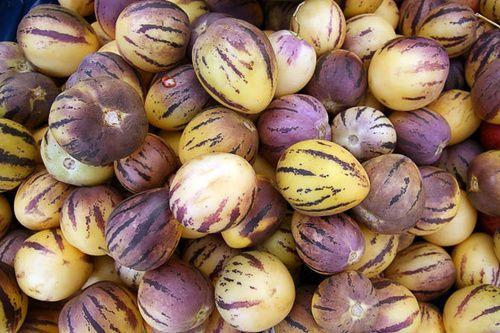The pepino dulce it is a fruit rich in fiber, with few sugars and many vitamins, useful in case of diabetes. Some archaeological finds testify to the familiarity of the ancient Andean peoples with this curious solanacea with a sweetish fruit, a palatable taste, rich in interesting properties and not so difficult to grow. Let's find out better
> 1. Description of the pepino dulce
> 2. Calories, properties and nutritional values of pepino dulce
> 3. Ally of
> 4. Contraindications of pepino dulce
> 5. Curiosities about pepino dulce
> 6. How to consume pepino dulce

Pepino dulce description
Let's talk about sweet Cucumber, fruit of Solanum muricatum, a solanacea native to the temperate Andean areas, especially Peruvian.
Call it pepino dulce, pepino melon, peramelone… little changes. The pepino dulce is a perennial solanacea that does not tolerate prolonged low temperatures but if well protected it is able to grow even here.
For commercial purposes it is grown a little throughout South America, from Colombia to Chile, however, there are historic farms that already produced pepino dulce in the States, Australia, New Zealand, East Africa and the Mediterranean basin between the 1880s and 1890s.
The flavor is particular: depending on the variety and the degree of ripeness it can remember cucumber, banana, melon, pineapple and tamarillo, its close relative.
Calories, properties and nutritional values of pepino dulce
The beautiful fruit of the pepino dulce, which it can recall certain tomatoes with a pointed enda, when ripe it has a varied and streaked color, with creamy orange and dark purple tones, suggesting the good content of antioxidant elements such as flavonoids. It is also a decent one source of dietary fiber.
The low sugar content and the good vitamin contents (especially vitamin C, A and K) are helpful in case of diabetes (also thanks to the ability of some of its phytochemical compounds to regulate the level of sugar in the blood) and the whole range of carotenoids contained have anti-inflammatory, antitumor, antivital, antimicrobial properties, and are ideal for cleanse the veins of bad cholesterol and to combat oxidative stress, especially for the skin and bones.
It also promotes good cholesterol and is, for example, recommended its consumption to recover after a heart attack. Thanks to a low sodium level, it is capable of lower the pressure.
Pepino dulce, ally of
Especially kidneys, but it is also indicated for the fight against diabetes and for the protection of coronary heart health. Skin and bones. Indicated in case of stomach ache and constipation.
Contraindications of Pepino dulce
No particular contraindications known. It is a good idea to always approach solanaceae gradually since some secondary metabolites contained in the fruit which are negligibly toxic for some, can cause onset of allergic reactionsand for others. So first a little taste, and hopefully proceed with the feast.
Curiosities about the pepino dulce
- The Spanish name "pepino dulce" gives us some clues about its organoleptic properties: pepino stands for cucumber, which is more or less its basic flavor (almost tasteless), while the term dulce alludes to the aftertaste that is somewhat reminiscent of pear, a little bit of melon and a little bit of banana.
- Due to the elegance of its long and pointed leaves, it is grown in Japan as an ornamental plant.
How to consume the pepino dulce
Generally, the fruit of the pepino dulce is "seen and likedSo to speak, because the best way to eat it is by far the natural one: you can easily eat all the parts: skin, pulp and very small seeds.
The best time to eat it is when the pulp is no longer tough and the color varies from green to orange streaked with purple or totally purple with small cream bands.
Purple is a sign of greater sweetness. Although the fruit is juicy, there are no juices around because the flavor is not very intense. Slices of sweet pepper are still excellent in classic mixed salad, in fruit salad and in couscous salad.
Acerola, paw paw and pepino dulce among the unknown fruits
| Efratnakash


























